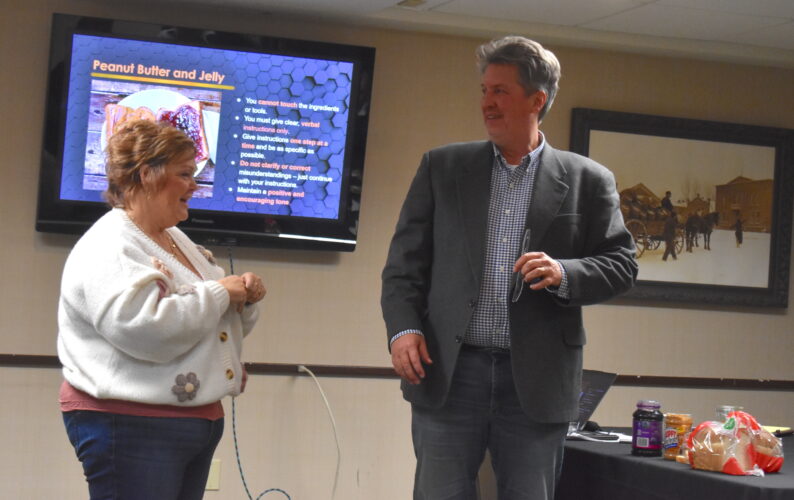Sandy Reinke (left) gives instructions to Vivid Image president Steve Gasser (right) on how to assemble a peanut butter and jelly sandwich during the New Ulm Chamber Hot Topic program on Artificial Intelligence (A.I.). The peanut butter and jelly sandwich demonstration was design to teach people how to write prompts for A.I. software.
NEW ULM – Artificial Intelligence (A.I.) technology such as Chat GPT, Gemini, Claude and Google
NotebookLM is quickly becoming commonplace. How best to use these tools effectively and ethically is a hot topic.
Friday the New Ulm Chamber hosted a seminar for local small businesses to use the latest A.I. tech to improve business operations. Steve Gasser, president of digital marketing company Vivid Image led a presentation on A.I. use in business.
“It was just two years ago that Chat GPT became real popular and we started hearing about all this A.I. stuff,” Gasser said.
Gasser compared concerns about A.I. to the concerns about using credit and debit cards at fast food restaurants. Thirty years ago, using a card to make small purchases at fast food locations seemed ridiculous, but today few people carry cash.

New Ulm Chamber Hot Topic program, Vivid Image president Steve Gasser worked to allay fears about using A.I. Gasser said he did not believe A.I. would replace humans, but he did believe humans using A.I. as a tool would be better prepared.
“The times are changing and A.I. is going to make things change a lot quicker,” he said.
The first lesson on using A.I. was how to formulate prompts. As an example of how to use A.I. prompts, Gasser had SSTC board member Sandy Reinke help. Reinke was asked to give him instructions on how to make a peanut butter and jelly sandwich through step-by-step commands. Reinke was ultimately successful in getting Gasser to create a sandwich, but it was not without its setbacks, including opening the loaf of bread wrong and spilling bread slices everywhere.
“It does take patience,” Gasser said. An early tip was to give the A.I. an identity and tell it what type of voice to use.
What type of business activities can an A.I. be used for?
Gasser’s recommendation for A.I. is using it to scale up on something a business is already doing well. If a business is great at sales, use A.I. to help brainstorm sales promotions and ads.
“It’s great for brainstorming–ideation,” he said.
At the start of the presentation, Gasser polled the attendees and found roughly half had used an A.I. too in their lives. Some were already using the technology for work.
State Street Theater executive director Lorie Jewell said she used A.I. to create press releases.
Lisa Besemer from New Ulm Real Estate said AI assisted with writing house descriptions.
Marie Guggisberg said she used A.I. to plan a vacation to Banff, Alberta, Canada.
Gasser was able to show attendees several examples of how AI could be used to help a business by generating resumes, creating business plans, or creating videos. During the presentation, Gasser showed an A.I.-generated video of him narrating a speech. He did write the speech, but the video was created by A.I. and his voice was replicated to match the speech. The video could even be translated into different languages.
Gasser said he has created A.I. videos of himself delivering speeches in other languages and it is fairly accurate. There are a few words it could get wrong.
He demonstrated this by using Chat GPT to write poems. Using a few prompts the A.I. produced a sonnet followed by a haiku.
After the demonstration, State Street Theater executive director Lorie Jewell asked if A.I. would poets out of business.
Gasser said multiple times in the presentation that he did not believe A.I. would replace humans, but he did believe humans using A.I. as a tool would be better prepared.
The focus of the presentation was what A.I. could be used for, but there were questions about how not to use A.I. Attendees were warned against using it to create content the user cannot evaluate.
“If you’re not good at human resource policy, you probably shouldn’t use A.I. for human resource policies because you don’t know what is good or bad,” Gasser said.
Vivid Image Client Director Amber Erickson gave a second example. Erickson said she knew nothing about hotel management and would never use A.I. to create a business plan for a hotel.
“I would have no way to verify if the information it generated was correct,” she said.
Gasser said that it is possible for A.I. to “hallucinate” answers. Certain prompts can generate nonsense answers.
There are also legal concerns about how A.I. generated material is used. Earlier in the presentation, Gasser said images created using A.I. generated technology cannot be copyrighted. While A.I. technology is getting better at differentiating between copyrighted material, there are still risks and users should not attempt to pass off A.I. generated work as their own original content.
“You don’t want to just take what A.I. gives you and put it out there,” Gasser said. “There has to be human eyes on it. There has to be human eyes on it. You have to do more with it.”
Vivid Image director Amber Erickson said there was an A.I. tool that would cite sources for generated information.
Gasser said today most A.I. will no longer take prompts from specific artists. New software can break down an A.I.-generated image into layers to determine the source.
“How much of this is taken from someplace else,” he said “You need to be aware of those legal considerations. Sometimes there is such a fear around this that it keeps us from doing anything. But I want you to get out and use it.”
Gasser has hosted these business seminars since June and said he sometimes worries he is not giving enough information, because the technology is changing very rapidly. He does hope the information he provides will encourage businesses to explore A.I. options.
Following the seminar Jewell and Reinke were discussing methods to use A.I. to augment what they are already doing at State Street Theater.
Jewell acknowledged she had concerns about A.I. being used to replicate a human singer. She did not want the tool to replace human performs, but believed A.I. there was a way to help with the creative process.
“The typewriter did not stop people from writing,” Jewell said. “It helped people write better.”
- Sandy Reinke (left) gives instructions to Vivid Image president Steve Gasser (right) on how to assemble a peanut butter and jelly sandwich during the New Ulm Chamber Hot Topic program on Artificial Intelligence (A.I.). The peanut butter and jelly sandwich demonstration was design to teach people how to write prompts for A.I. software.
- New Ulm Chamber Hot Topic program, Vivid Image president Steve Gasser worked to allay fears about using A.I. Gasser said he did not believe A.I. would replace humans, but he did believe humans using A.I. as a tool would be better prepared.







